More news
- Focus on the global coatings market: Global coatings market outlook
- View from the UK: Navigating chemical policy and sustainability
- Focus on adhesives: Henkel and Covestro collaborate for sustainability of engineered wood ...
- Advances in construction chemical technology: What’s new in 2024?
- Focus on sustainability: PPCJ speaks to BASF Dispersions Asia Pacific about its holistic a...

Adhesives serve as the backbone that binds together various materials and components in manufacturing processes. Their significance lies in their ability to provide efficient and reliable bonding solutions. This paper provides an overview of the methodologies and instrumentation used to test the physical properties of adhesives, including viscosity, tensile and shear strength, adhesion, moisture, film thickness, and more. Understanding these properties and the synergy of adhesives, coatings, sealants, and elastomers is vital for quality control, product development, and the successful implementation of adhesives in diverse industries
Table of Contents
- Viscosity Testing for Optimal Application2
- Moisture Testing for Preventing Adverse Effects on Performance 4
- Adhesive Film Thickness Testing for Ensuring Uniformity in Application 5
- Tensile and Shear Strength Testing for the Structural Integrity of Bonded Joints5
- Adhesion Testing for Strength and Durability of Bond6
- Synergy of Adhesives, Coatings, Sealants, and Elastomers 6
Adhesives are critical because they provide a versatile and efficient means of joining materials, enhancing the structural integrity and performance of products across various industries, from aerospace and automotive manufacturing to healthcare and construction. They enable lightweight, durable, and aesthetically pleasing designs while often reducing the need for mechanical fasteners, which can add weight and complicate assembly processes. Their physical properties heavily influence their performance, requiring thorough testing to ensure their suitability for intended applications.
Viscosity testing ensures optimal application, while mechanical properties like tensile and shear strength dictate the structural integrity of bonded joints. Adhesion testing ensures the strength and durability of the bond, while moisture testing prevents adverse effects on performance, and film thickness testing ensures conformity. The precise understanding and control of these physical properties are paramount for engineers and manufacturers, as they enable the selection of adhesives tailored to specific applications, ensuring durability, safety, and efficiency in industrial processes. Synergy with Coatings, Sealants, and Elastomers also collectively enhance product performance and reliability in various applications.
-
Viscosity Testing for Optimal Application
Viscometers measure the adhesive’s viscosity and are essential in physical testing applications, as the viscosity of a fluid can provide insights into its properties and behavior. Viscosity is measured in centipoise (cP) or poise (P), indicating the adhesive’s resistance to flow. In general, adhesives with higher viscosity are more resistant to flow than those with a lower viscosity. Viscosity is critical in adhesive applications, influencing the ease of handling and application. Tailoring the viscosity of adhesives to specific application requirements ensures optimal performance, bond strength, and reliability in diverse industrial settings.
Viscosity, in the Context of Adhesives, Impacts Several Vital Aspects:
- Ease of Application:
Low-viscosity adhesives flow more easily, making them suitable for fast, uniform coverage applications. They often penetrate porous substrates or where intricate details exist to bond.
High-viscosity adhesives tend to be more flow-resistant, providing better control during application. They are great for vertical or overhead surfaces, preventing dripping or sagging.
- Penetration and Wetting:
Low-viscosity adhesives penetrate and wet the surface more effectively, ensuring contact with the substrate to achieve a durable bond, especially on porous or irregular surfaces.
High-viscosity adhesives may not penetrate as quickly but form thicker bonds and are preferable in applications with essential gap-filling properties.
- Bond Thickness
Viscosity control is crucial for manufacturers to achieve the desired bond line thickness, which is critical for performance.
- Curing and Setting Time
Low-viscosity adhesives exhibit faster curing times as they can spread more quickly, have improved contact with the substrate, and are advantageous in applications requiring quick assembly or rapid bonding.
High-viscosity adhesives may have longer set times, allowing for adjustments and proper alignment of parts before curing.
- Consistency in Manufacturing – Viscosity Stability
Maintaining consistent viscosity is crucial to ensure uniform application and reliable bonding. Quality control measures often involve monitoring and adjusting viscosity to meet specified requirements.
- Temperature Sensitivity- Viscosity Changes with Temperature
Viscosity is often temperature-dependent. Adhesives may experience changes in viscosity when exposed to different temperatures. Understanding and controlling these changes are essential for consistent performance in various environments.
Types of Viscosity Testers for Adhesives
Several types of test instruments are commonly used to measure the viscosity of adhesives. The choice of instrument depends on factors such as the type of adhesive, its viscosity range, and the specific requirements of the testing procedure. Here are some common types of instruments used to test the viscosity of adhesives:
Cone and Plate Viscometers determine viscosity by measuring the shear stress and shear rate when the cone rotates against the plate. Use the resulting data to calculate the viscosity and assess adhesives’ rheological behavior under controlled shear conditions.
- Rotational Viscometers, also known as Vane viscometers, utilize the rotation of a spindle in a cup to measure the adhesive’s viscosity. Determine the viscosity by measuring the torque on a vertical shaft that rotates the spindle.
- Capillary Viscometers measure viscosity by determining the flow rate of a specific volume of adhesive through a narrow tube (the capillary) and are suitable for low to moderately viscous adhesives. The fluid’s viscosity is calculated based on the flow rate and the dimensions of the capillary tube.
- Viscosity Cups are a less expensive option for testing the viscosity of an adhesive. They are used in viscosity testing, where the number of seconds required is measured for a set volume of adhesive to flow through the viscometer’s orifice. The Stein Hall viscosity cup is commonly used for adhesives however the readings obtained do not directly correspond with any other viscosity Scale.
Image caption: byko-visc Rotational Viscometer
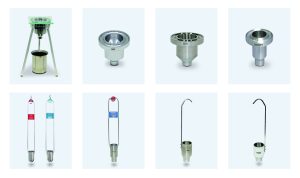
Image caption: Gardco Viscosity Cups
When choosing a viscometer for adhesives, consider the sample specifications, composition, instrument compatibility, measurement goals, parameters, operating costs, and the time needed to complete the measurements and analyse your data.
-
Moisture Testing for Preventing Adverse Effects on Performance
Moisture analysers, also known as moisture balances or moisture meters, are instruments designed to provide a quantitative measure of adhesive water content and are used for quality control, process optimization, and prevention of adverse effects. These analysers play a crucial role in the adhesive industry, where controlling moisture content is essential for maintaining product quality, performance, and durability.
Adverse Effects of Excess Moisture:
- Reduced bonding strength
- Extended curing times or incomplete curing
- Changes in physical or chemical properties
- Reduction in shelf life and increased susceptibility to microbial growth.
Types of Moisture Analysers Used for Adhesives:
 Resistance moisture meters measure the electrical resistance between two electrodes in contact with the adhesive. They suit various adhesive types, including solids, liquids, and pastes.
Resistance moisture meters measure the electrical resistance between two electrodes in contact with the adhesive. They suit various adhesive types, including solids, liquids, and pastes.- Capacitance moisture meters measure the dielectric properties of the adhesive, which change with moisture. Effective for measurement of humidity in non-conductive adhesives.
- Nuclear or neutron moisture meters measure the hydrogen content in adhesives. Practical for both contact and non-contact measurements in various adhesive formulations.
- Radio Frequency (RF) moisture meters use radio frequency signals to measure the dielectric properties of the adhesive, which change the moisture content. They are practical for both contact and non-contact measurements in various adhesive types.
- Handheld moisture meters are portable, easy-to-use meters with different measurement principles, such as resistance or capacitance. It is ideal for field measurements, quality control, and spot-checking adhesive moisture content.
Image caption: BYK m200 Handheld Resistance Moisture Meter
The choice of moisture meter depends on factors such as the type of adhesive, the expected moisture range, the required measurement accuracy, and the specific characteristics of the manufacturing process. Manufacturers often use a combination of moisture meters to ensure comprehensive control and monitoring.
-
Adhesive Film Thickness Testing for Ensuring Uniformity in Application
Testing film thickness in adhesives is a critical quality control measure. It ensures uniformity and consistency, helps achieve the desired bonding performance, prevents overconsumption, and ensures that the adhesive application meets specified requirements and industry standards.
Types of Film Thickness Testers Used for Adhesives:
- Wet film thickness gauges are a simple tool used to measure the thickness of the adhesive layer while it is still wet. Applying the correct amount of adhesive before curing is helpful during the application process.
- Dry film thickness gauges measure the thickness of the adhesive layer after it has dried or cured and are helpful for quality control Gardco Wet Film Thickness Gauge by ensuring the final cured adhesive layer meets specified thickness requirements.
 Magnetic film thickness gauges use a magnetic principle to measure the thickness of non-magnetic coatings, including some adhesives. They are suitable for measuring dry film thickness on ferrous substrates.
Magnetic film thickness gauges use a magnetic principle to measure the thickness of non-magnetic coatings, including some adhesives. They are suitable for measuring dry film thickness on ferrous substrates.- Ultrasonic thickness gauges use ultrasonic waves to measure the thickness of materials, including adhesive layers. Suitable for measuring the thickness of cured or dried adhesive layers on various substrates.
Image caption: byko-test Dry Film Thickness Gauge
The choice of a film thickness gauge depends on the testing application requirements, the desired precision level, and the available budget.
-
Tensile and Shear Strength Testing for the Structural Integrity of Bonded Joints
The Tensile test is a standard method to evaluate the strength and performance of adhesives. Tensile test machines or tensile testers are universal testing instruments (UTMs) specially configured to assess the tensile strength of specimens and can be configured to perform shear tests as well. Adhesive testing involves the adhesive bonding two sample substrates together and then measuring the tensile strength by applying tension to the sample held between two vises and then stretching it by pulling it apart. Tensile testers will measure ultimate tensile strength, yield strength, elongation, and modulus.
Types of Tensile and Peel Testers for Adhesives
 Micro-tensile testers are for small-scale specimens where limited adhesive is available.
Micro-tensile testers are for small-scale specimens where limited adhesive is available.- Single-column tensile testers are for small and medium-sized adhesive specimens.
- Dual-column tensile testers are for larger adhesive specimens or materials with higher tensile strength requirements.
- Peel testers are equipped with fixtures to assess the peel strengths of adhesive bonds.
Image caption: Oakland FX-7100-VFC Peel and Seal Tester from Gardco
The choice of a tensile tester depends on the testing application requirements, the size and type of specimen, the expected force, and testing conditions.
-
Pull-Off Adhesion Testing for Strength and Durability of Adhesive Bonds
Pull-off adhesion testing is a crucial method used to evaluate the strength and durability of adhesive bonds, providing valuable insights into their performance under various conditions. Pull-off or tensile adhesion testing is a standardized method for measuring the force required to separate an adhesive bond from a substrate. These tests use specialized equipment that applies a known force to a sample and then measures the displacement. After the test, evaluate the mode of failure (adhesive, cohesive, or substrate failure) and calculate the adhesion strength based on the maximum force applied and the surface area of the loading fixture. By quantifying the force required for bond failure, users can assess the adhesion strength and reliability of the adhesive system.
Types of Pull-off Adhesion Testers for Adhesives
- Manual pull-off adhesion testers: These testers typically involve a handheld device with a calibrated gauge and a pulling mechanism. The operator manually applies force to detach the adhesive from the substrate while monitoring the force applied.
- Hydraulic pull-off adhesion testers: These testers utilize hydraulic pressure to apply a controlled force to detach the adhesive. They offer more consistent and precise results than manual testers and are suitable for high-strength adhesive testing.
- Pneumatic pull-off adhesion testers: Like hydraulic testers, pneumatic testers apply force using compressed air. They are often more portable and accessible to operate than hydraulic testers but can still provide accurate results for many adhesive applications.
- Automatic pull-off adhesion testers: These fully automated testers can apply a predetermined force to the adhesive bond. They offer high precision and repeatability and are suitable for quality control purposes in industrial settings.
 Dolly pull-off adhesion testers: After preparing the test surface, a loading fixture or “dolly” is attached to the surface using the text adhesive. The pull-off tester is then attached to the dolly, and a gradually increasing force is applied perpendicular to the test surface. After the test, evaluate the mode of failure (adhesive, cohesive, or substrate failure) and calculate the adhesion strength based on the maximum force applied and the surface area of the loading fixture.
Dolly pull-off adhesion testers: After preparing the test surface, a loading fixture or “dolly” is attached to the surface using the text adhesive. The pull-off tester is then attached to the dolly, and a gradually increasing force is applied perpendicular to the test surface. After the test, evaluate the mode of failure (adhesive, cohesive, or substrate failure) and calculate the adhesion strength based on the maximum force applied and the surface area of the loading fixture.
Image caption: Positest Pull-Off Adhesion Tester from Gardco
Adhesion strength is a critical parameter in determining the performance of bonded materials. Weak adhesion can lead to bond failure, compromising the structural integrity of assembled components and resulting in costly repairs or product recalls. The choice of adhesion testers depends on the application’s specific requirements, the desired precision level, and the available budget.
-
Synergy of Adhesives, Coatings, Sealants, and Elastomers
Adhesives, coatings, sealants, and elastomers collaborate harmoniously and have a collective impact on enhancing product performance, durability, and reliability in various applications. Each component contributes unique properties to the overall system, such as adhesion strength, corrosion resistance, flexibility, and resilience. By understanding the interplay between these components, we can appreciate the intricate mix of chemistry and engineering that is the basis of modern bonding and protection technologies.
- Performance
Adhesives provide the initial bond, coatings offer protection and finish, sealants ensure impermeability, and elastomers provide flexibility and resilience. Each component is critical to the final product’s overall performance. When choosing materials, it is crucial to consider the compatibility and integration of the materials to achieve optimal performance and longevity.
- Enhancing Properties for Durability and Reliability
- Improved adhesion and assembly strength: By using the appropriate adhesive, manufacturers can achieve bonds that are often stronger than the joined materials. The proper adhesive also enhances the overall structural integrity of products, reducing the likelihood of failure or detachment.
- Enhanced corrosion resistance: Coatings protect against environmental factors such as moisture, corrosion, abrasion, and UV radiation. By shielding the underlying substrate from these damaging elements, coatings extend the lifespan of products and maintain their appearance over time. This protection is essential in automotive, aerospace, and marine industries, where exposure to harsh conditions is common.
- Sealing capabilities: Sealants prevent moisture, air, dust, and other contaminants from entering joints or gaps between surfaces. By creating a tight seal, sealants protect internal components from corrosion, water damage, and premature wear. This prevention of contaminants is critical in construction, automotive manufacturing, and electronics assembly applications, where sealing is essential for maintaining functionality and reliability.
- Flexibility and resilience: Elastomers offer flexibility and resilience, allowing them to withstand deformation and recover their original shape after being subjected to mechanical stress or environmental changes. This property is particularly advantageous in sealing applications with dynamic movement or vibration. Elastomers ensure a tight and reliable seal over time, even in challenging operating conditions.
Overall, the collective use of adhesives, coatings, sealants, and elastomers in product design and manufacturing contributes to improved performance, durability, and reliability across various industries, ultimately leading to higher customer satisfaction and reduced maintenance costs over the product lifecycle.
Testing adhesives’ physical properties is paramount to manufacturers and users to ensure their reliability, performance, and suitability for diverse applications. The decision of which testers to use depends on the type of adhesive, substrate material, desired measurement accuracy, and the application’s specific requirements. Testing the physical properties of adhesives, such as viscosity, tensile and shear strength, hardness, moisture, and film thickness, is a fundamental step in developing, manufacturing, and applying these crucial bonding agents. In essence, the performance of adhesives in industrial settings is a testament to the careful consideration and mastery of their physical attributes. Adhesives, coatings, sealants, and elastomers harmoniously collaborate and have a collective impact on enhancing product performance, durability, and reliability in various applications.




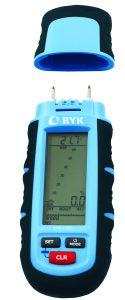 Resistance moisture meters measure the electrical resistance between two electrodes in contact with the adhesive. They suit various adhesive types, including solids, liquids, and pastes.
Resistance moisture meters measure the electrical resistance between two electrodes in contact with the adhesive. They suit various adhesive types, including solids, liquids, and pastes.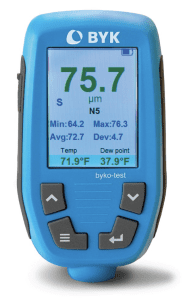 Magnetic film thickness gauges use a magnetic principle to measure the thickness of non-magnetic coatings, including some adhesives. They are suitable for measuring dry film thickness on ferrous substrates.
Magnetic film thickness gauges use a magnetic principle to measure the thickness of non-magnetic coatings, including some adhesives. They are suitable for measuring dry film thickness on ferrous substrates.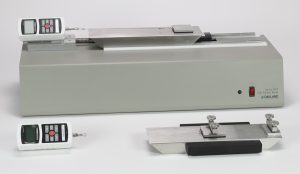 Micro-tensile testers are for small-scale specimens where limited adhesive is available.
Micro-tensile testers are for small-scale specimens where limited adhesive is available.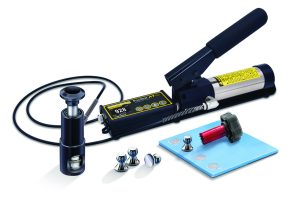 Dolly pull-off adhesion testers: After preparing the test surface, a loading fixture or “dolly” is attached to the surface using the text adhesive. The pull-off tester is then attached to the dolly, and a gradually increasing force is applied perpendicular to the test surface. After the test, evaluate the mode of failure (adhesive, cohesive, or substrate failure) and calculate the adhesion strength based on the maximum force applied and the surface area of the loading fixture.
Dolly pull-off adhesion testers: After preparing the test surface, a loading fixture or “dolly” is attached to the surface using the text adhesive. The pull-off tester is then attached to the dolly, and a gradually increasing force is applied perpendicular to the test surface. After the test, evaluate the mode of failure (adhesive, cohesive, or substrate failure) and calculate the adhesion strength based on the maximum force applied and the surface area of the loading fixture.


